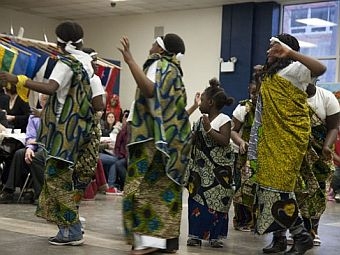 (Host) Today we conclude our series, Vermont Reads, To Kill a Mockingbird, VPR’s collaboration with the Vermont Humanities Council’s statewide reading program. Today, we explore how we talk to young children about race.
(Host) Today we conclude our series, Vermont Reads, To Kill a Mockingbird, VPR’s collaboration with the Vermont Humanities Council’s statewide reading program. Today, we explore how we talk to young children about race.
The Burlington School District is the most diverse in the state. More than 60 countries are represented in the student body, and 27 percent of the students are of color. It’s a multiracial, multicultural environment – and one that the district works hard to make inclusive.
VPR’s Angela Evancie has more.
(Evancie) Once a year, Burlington High School holds a dinner called "Shades of Ebony." It’s a celebration for everyone who participates in BHS’s academic support program. There’s food and music – and since this is BHS, the event doubles as a multicultural celebration.
(Evancie) Students from Bosnia and Burundi perform, and families of every color are in the audience.
(Emcee) Give it up! [applause]
(Evancie) But here’s the thing: in Burlington schools, every day is a multicultural celebration.
(Zabili) "As you can see, walking into our lobby, they have flags of every country up there…"
(Evancie) Bodel Zabili is a senior at Burlington who came from the Congo.
(Zabili) "If you got a new student, and they didn’t have their flag up there, they’ll make sure right away to get their flag up there. No one is left out and everyone is recognized."
(Evancie) Zabili says he loves going to BHS.
(Zabili) "You get to meet all sorts of new people every day, people you wouldn’t normally interact with at other schools."
(Evancie) Lamia Sehic is in the 5th grade. She’s from Bosnia, but she has friends from around the world.
(Sehic) "It’s really good because sometimes if you’re close friends or you can meet them and they tell you about what their stuff is and you tell them about what your religion and what you do, and so then you get to know more stuff."
(Evancie) Dr. Dan Balón is the Director of Diversity and Equity for the Burlington School District. He says he always feels a positive energy when he walks through the hallways.
(Balón) "And I think it has a lot to do with how well our teachers and administrators have created that climate. You know it’s one thing when you have diversity, but if we’re not doing much to make it work, that’s a problem."
(Evancie) The Diversity and Equity Office is doing a lot to "make it work." They’re recruiting teachers and administrators as diverse as the student body. And they’re helping those who already work in the district to build a safe and open learning environment.
(Balón) "We all know that student success is really anchored by how teachers are creating that classroom environment, so we have really emphasized in the last few years particularly, cultural competency, when we create that environment, when we’re teaching a lesson, or how we teach that lesson."
(Evancie) Burlington students also participate in a national program called "Reading to End Racism." Community members visit classrooms and help lead discussions about racism and discrimination. Dr. Denise Dunbar is the Chittenden County Coordinator for the program.
(Dunbar) "We touch on all topics, whether it’s the plight of indigenous Americans, or global indigenous people, to immigrants and migrants, new Americans, refugees – the experience of all people that have been on the margins."
(Evancie) Dr. Dunbar says it’s helpful for students if adults reflect on their own experiences with racism.
(Dunbar) "We all have at some time in our life experienced racism whether we have been the receiver, or the giver, or the person that stood by."
(Evancie) And the same goes for Burlington students. Chaska Richardson teaches English to students who came here from abroad. She says that students do experience racism from time to time. But what’s important is that there’s an open dialogue in the classroom.
(Richardson) "What I want my students to understand first and foremost is that it’s okay to talk about race. It’s not always comfortable – it’s really important, though…So that there isn’t confusion about what words might be used when children think it’s just a joke, or how to understand how hurtful that really is. And children also need to be able to explore their own ideas and questions about race, but if we don’t give them that opportunity, they’ll come to their own conclusions."
(Evancie) At the end of the day, diversity director Dan Balón says that it’s all about the personal connections.
(Balón) "You know, we could always say you could attend a workshop, go to a conference, but I think the work is very personal. And the extent to which you bring that into the classroom, students feel and they touch and they remember, and all of that contributes to students – of whatever background – learning, and that is our ultimate goal."
For VPR News, I’m Angela Evancie.